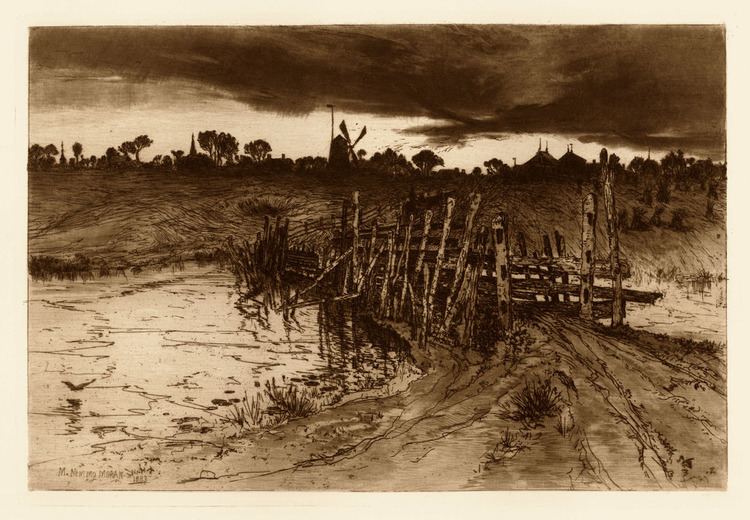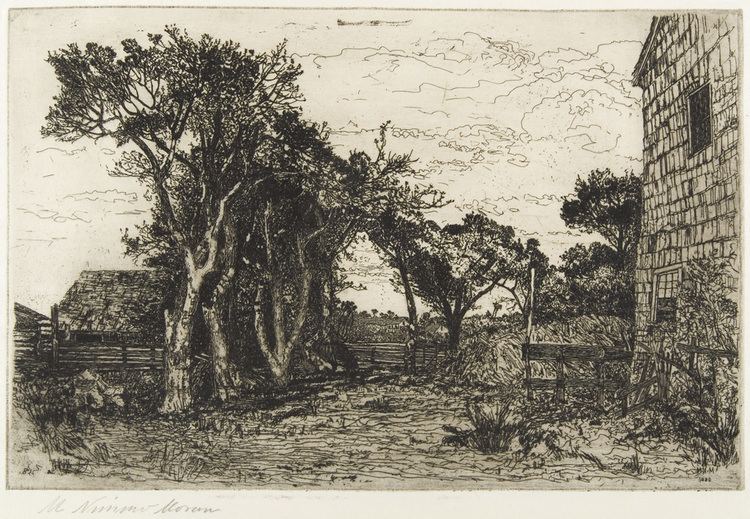Name Mary Moran | Died 1889, East Hampton | |
 | ||
Mary Nimmo Moran (1842–1899) was a prominent American 19th-century landscape artist specializing in etchings. She completed roughly 70 landscape etchings, which included scenes of England and Scotland, as well as Long Island, New Jersey, Florida and Pennsylvania. She was elected to the Society of Painter- Etchers and became the only female member of the Fellows of London's Royal Society of Painter-Etchers. She was the wife of American artist and illustrator Thomas Moran.
Contents

Biography

Born in Scotland, Mary Nimmo and her brother emigrated to the United States in 1847 with their widowed father, Archibald, a weaver. The family settled in Crescentville, Philadelphia, Pennsylvania, near a family of English immigrants named Moran. At age 18, she began to study drawing and painting at the Pennsylvania Academy of Fine Arts, studying with her neighbor Thomas Moran, who was then gaining a local reputation as an artist. Two years later, the couple married and moved to Philadelphia where they had two daughters and a son. In 1879, her husband introduced Nimmo Moran to the technique of etching by directly engraving onto a copper plate. She made most of her etchings on location near her various homes, as responsibilities to her growing family allowed her to travel only occasionally.
To avoid unsettling potential purchasers by openly declaring her gender, Nimmo Moran chose to exhibit her prints as 'M. Nimmo Moran'. She was elected to the Society of Painter-Etchers of New York and became the only woman among the 65 original Fellows of London's Royal Society of Painter-Etchers. Her prints were recognized for their boldness and originality, and were collected by the English critic John Ruskin and others.
The Moran family relocated to Newark, New Jersey in 1872. In 1884 they moved to East Hampton, Long Island, which became the subject of many of Nimmo Moran's most successful etchings. The Moran home in East Hampton became the center of a productive artists' colony and is today a National Historic Landmark.
Early life
Nimmo Moran was born in Strathaven, Scotland in 1842 to Mary and Alfred Nimmo, a family of weavers. Following the death of her mother in 1847, when Nimmo Moran was five, her father moved the young girl and her brother to America, settling down in Crescentville, Pennsylvania, just outside of Philadelphia, in 1858. Here, they were neighbors to the English immigrant family the Morans, whose son Thomas she would later marry. The Morans were a family of prominent artists, and Mary was able to bond with them over their shared interest in the arts.
Nimmo Moran was described as simultaneously charming, personable, and bright and modest and humble. Notably, she was well-versed in many different fields of artistry.
Death
Moran died of typhoid fever in 1899, after nursing her daughter Ruth through the disease, and was buried beside Goose Pond, a subject of many of her etchings, near her home in East Hampton.
Auction record
On 9 June 2011, Swann Galleries auctioned Mary Nimmo Moran's Long Island Landscape, an 1880 oil on panel, which was her first painting to appear at auction. It sold for $64,800.
